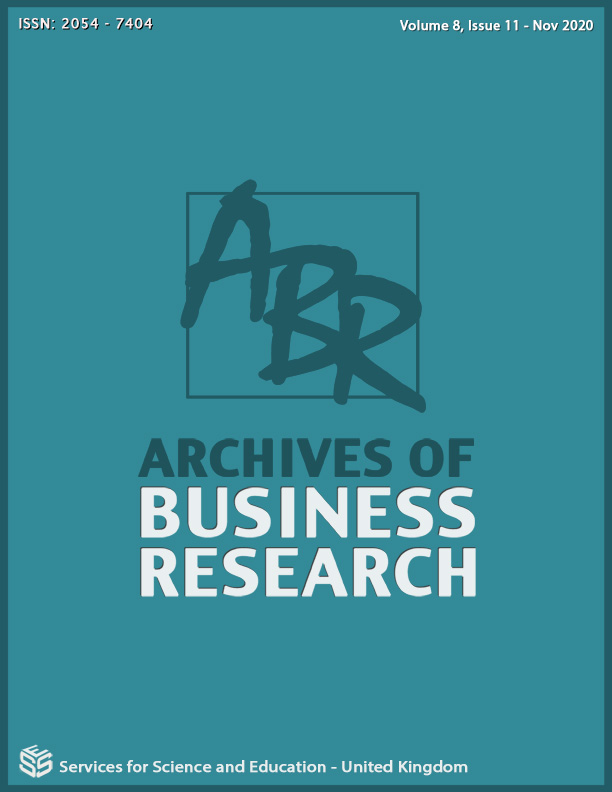Japanese Recruitment Practices in Times of Crisis
DOI:
https://doi.org/10.14738/abr.811.9365Keywords:
Recruitment, Human resource management, Japanese managementAbstract
This paper examines past recruitment practices to provide insight into how Japanese companies have adapted during times of crisis. A literature review combining company surveys and government-related statistical data was used. It was found that many large companies adapted recruitment processes in varying degrees to deal with the changing economic environment. These changes include varying the number of hires and diversifying hiring conditions. Although many Japanese companies adapt their recruitment processes, they seem resistant to change their overall recruitment strategy even during a crisis.
References
Robinson, P. (2003). The embeddedness of Japanese HRM practices: The case of recruiting. Human Resource Management Review, 13, 439-65.
Jacoby, S.M. (2005). The Embedded Corporation: Corporate Governance and Employment Relations in Japan and the United States. Princeton, Princeton University Press.
Jackson, K., and Tomioka, M. (2004). The Changing Face of Japanese Management. London, Routledge.
Takeda, M. (2002). “Human Relations Management,” in Bird, A.(Ed.) Encyclopedia of Japanese Business and Management. London, Routledge.
Sasaki, N. (1990). Management and Industrial Structure in Japan (2nd ed.). Oxford, Pergamon.
Haak, R., and Pudelko, M. (2005). Japanese Management: The Search for a New Balance between Continuity and Change. London, Palgrave Macmillan.
Kono, T., and Clegg, T. (2001). Trends in Japanese Management: Continuing Strengths, Current Problems, and Changing Priorities. New York, St Martins Press.
Works Institute. (2006). Recruitment Survey (in Japanese). Tokyo, Recruit.
BHCP. (2006). Survey on Recruitment (in Japanese). Tokyo, Bunka Hoso Career Partners.
NKS (2006) ‘Survey on recruitment planning’, Nihon Keizai Shimbun, 26 April.
Works Institute. (2006). Recruitment Survey (in Japanese). Tokyo, Recruit.
Toyo Keizai. (2007). New Recruits Seasonal Report (in Japanese). Tokyo, Toyo Keizai.
MHLW. (2006). Survey on Youth Employment (in Japanese). Tokyo, Ministry of Health, Labour, and Welfare.
NKS (2009a) ‘Job hunting frontline’, Nihon Keizai Shimbun, 9 September.
NKS (2009b) ‘Job offer survey for next spring’, Nihon Keizai Shimbun, 18 October.
NKS (2010a) ‘Students job hunting up until graduation’, Nihon Keizai Shimbun, 4 February.
NKS (2011) ‘Record low 68.8% of university graduates receive job offer’, Nihon Keizai Shimbun, 18 January.
NKS (2008a) ‘First time in nine years that over 80% of university graduates received job offers’, Nihon Keizai Shimbun, 17 January.
Natsume, K. (2007). New Recruit White Paper 07/08 (in Japanese). Tokyo, Labor Productivity Information Center.
Toyo Keizai. (2008). New Recruits Seasonal Report (in Japanese). Tokyo, Toyo Keizai.
Natsume, K. (2007). New Recruit White Paper 07/08 (in Japanese). Tokyo, Labor Productivity Information Center.
JILPT. (2005). A Survey of Second Graduate Recruitment (in Japanese). Tokyo, Japan Institute for Labour Policy and Training.
Dickie, M. (2011) ‘Rethinking Japan's white-collar hiring’, Financial Times, 25 January.
KN (2010) ‘Japanese firms opening doors for more foreign students’, Kyodo News, 10 October.
NKS (2010b) ‘Recruiting recent university graduates important’, Nihon Keizai Shimbun, 26 July.
Jacoby, S.M. (2005). The Embedded Corporation: Corporate Governance and Employment Relations in Japan and the United States. Princeton, Princeton University Press.
Jackson, K., and Tomioka, M. (2004). The Changing Face of Japanese Management. London, Routledge.
Takeda, M. (2002). “Human Relations Management,” in Bird, A.(Ed.) Encyclopedia of Japanese Business and Management. London, Routledge.
Sasaki, N. (1990). Management and Industrial Structure in Japan (2nd ed.). Oxford, Pergamon.
Haak, R., and Pudelko, M. (2005). Japanese Management: The Search for a New Balance between Continuity and Change. London, Palgrave Macmillan.
Kono, T., and Clegg, T. (2001). Trends in Japanese Management: Continuing Strengths, Current Problems, and Changing Priorities. New York, St Martins Press.
Works Institute. (2006). Recruitment Survey (in Japanese). Tokyo, Recruit.
BHCP. (2006). Survey on Recruitment (in Japanese). Tokyo, Bunka Hoso Career Partners.
NKS (2006) ‘Survey on recruitment planning’, Nihon Keizai Shimbun, 26 April.
Works Institute. (2006). Recruitment Survey (in Japanese). Tokyo, Recruit.
Toyo Keizai. (2007). New Recruits Seasonal Report (in Japanese). Tokyo, Toyo Keizai.
MHLW. (2006). Survey on Youth Employment (in Japanese). Tokyo, Ministry of Health, Labour, and Welfare.
NKS (2009a) ‘Job hunting frontline’, Nihon Keizai Shimbun, 9 September.
NKS (2009b) ‘Job offer survey for next spring’, Nihon Keizai Shimbun, 18 October.
NKS (2010a) ‘Students job hunting up until graduation’, Nihon Keizai Shimbun, 4 February.
NKS (2011) ‘Record low 68.8% of university graduates receive job offer’, Nihon Keizai Shimbun, 18 January.
NKS (2008a) ‘First time in nine years that over 80% of university graduates received job offers’, Nihon Keizai Shimbun, 17 January.
Natsume, K. (2007). New Recruit White Paper 07/08 (in Japanese). Tokyo, Labor Productivity Information Center.
Toyo Keizai. (2008). New Recruits Seasonal Report (in Japanese). Tokyo, Toyo Keizai.
Natsume, K. (2007). New Recruit White Paper 07/08 (in Japanese). Tokyo, Labor Productivity Information Center.
JILPT. (2005). A Survey of Second Graduate Recruitment (in Japanese). Tokyo, Japan Institute for Labour Policy and Training.
Dickie, M. (2011) ‘Rethinking Japan's white-collar hiring’, Financial Times, 25 January.
KN (2010) ‘Japanese firms opening doors for more foreign students’, Kyodo News, 10 October.
NKS (2010b) ‘Recruiting recent university graduates important’, Nihon Keizai Shimbun, 26 July.
Downloads
Published
2020-11-27
How to Cite
Firkola, P. (2020). Japanese Recruitment Practices in Times of Crisis. Archives of Business Research, 8(11), 174–179. https://doi.org/10.14738/abr.811.9365
Issue
Section
Articles






